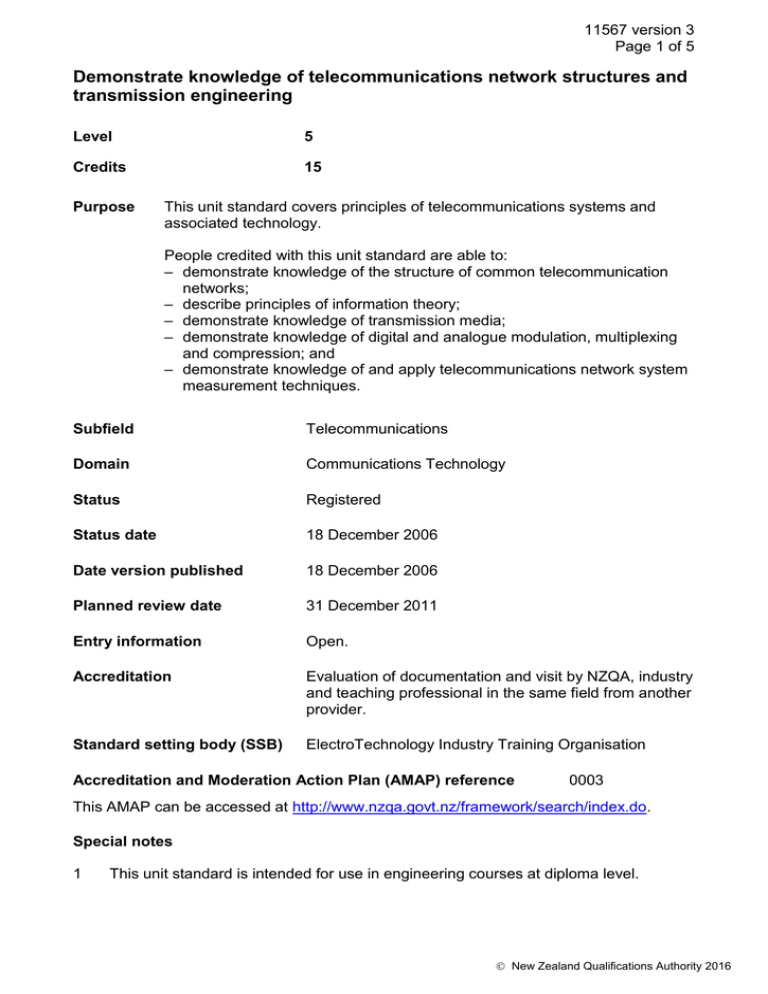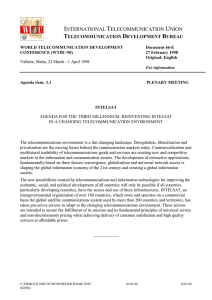Demonstrate knowledge of telecommunications network structures and transmission engineering
advertisement

11567 version 3 Page 1 of 5 Demonstrate knowledge of telecommunications network structures and transmission engineering Level 5 Credits 15 Purpose This unit standard covers principles of telecommunications systems and associated technology. People credited with this unit standard are able to: – demonstrate knowledge of the structure of common telecommunication networks; – describe principles of information theory; – demonstrate knowledge of transmission media; – demonstrate knowledge of digital and analogue modulation, multiplexing and compression; and – demonstrate knowledge of and apply telecommunications network system measurement techniques. Subfield Telecommunications Domain Communications Technology Status Registered Status date 18 December 2006 Date version published 18 December 2006 Planned review date 31 December 2011 Entry information Open. Accreditation Evaluation of documentation and visit by NZQA, industry and teaching professional in the same field from another provider. Standard setting body (SSB) ElectroTechnology Industry Training Organisation Accreditation and Moderation Action Plan (AMAP) reference 0003 This AMAP can be accessed at http://www.nzqa.govt.nz/framework/search/index.do. Special notes 1 This unit standard is intended for use in engineering courses at diploma level. New Zealand Qualifications Authority 2016 11567 version 3 Page 2 of 5 2 This unit standard is one of two designed to cover knowledge of telecommunications engineering, the other being Unit 11568, Describe and apply telecommunications transmission engineering and testing techniques. It is recommended that competency in this unit standard be achieved before assessment against unit standard 11568 is attempted. 3 It is recommended that competency in Unit 22721, Demonstrate and apply fundamental knowledge of electrical circuit engineering principles; Unit 22722, Demonstrate and apply introductory knowledge of electrical circuit engineering principles; and Unit 22726, Demonstrate and apply introductory knowledge of electronic engineering; be achieved before assessment against this unit standard is attempted, or equivalent knowledge and skills demonstrated. 4 Reference Health and Safety in Employment Act 1992; and all subsequent amendments and replacements. 5 Definitions AM – amplitude modulation. Cable – any or all of copper cable, fibre optic cable, coaxial cable. FDM – frequency division multiplexing. FM – frequency modulation. Industry practice – practice used and recommended by organisations involved in the electrotechnology industry. PAM – pulse amplitude modulation. PCM – pulse code modulation. PM – phase modulation. TDM – time division multiplexing. TDR – time domain reflectometry. 6 All measurements are to be expressed in Système International (SI) units, and, where required, converted from Imperial units into SI units. 7 All activities must comply with: any policies, procedures, and requirements of the organisations involved; the standards of relevant professional bodies; and any relevant legislative and/or regulatory requirements. 8 Range Performance in relation to the elements of this unit standard must comply with the Health and Safety in Employment Act 1992. New Zealand Qualifications Authority 2016 11567 version 3 Page 3 of 5 Elements and performance criteria Element 1 Demonstrate knowledge of the structure of common telecommunication networks. Range voice and data networks; public and private radio networks; wired and wireless telecommunication networks. Performance criteria 1.1 Common telecommunication networks are described in terms of the general structure, characteristics, and functions in accordance with industry practice. Range characteristics may include but are not limited to – purpose, scope, use of concepts. Element 2 Describe principles of information theory. Performance criteria 2.1 Principles of information theory are described in accordance with industry practice. Range relationship between capacity, bandwidth and noise; relationship between sampling rate and signalling frequency; Fourier analysis of a periodic signal. Element 3 Demonstrate knowledge of transmission media. Range copper cable, fibre optic cable, coaxial cable, wireless. Performance criteria 3.1 Fundamental properties of transmission media are explained. Range 3.2 primary coefficients, impedance, attenuation, bandwidth. Transmission media used in telecommunications are described in accordance with industry practice. Range construction, termination, operation, application (including use of repeaters, standards – NZ where applicable, structured cabling). New Zealand Qualifications Authority 2016 11567 version 3 Page 4 of 5 Element 4 Demonstrate knowledge of digital and analogue modulation, multiplexing and compression. Range purpose; digital and analogue AM, FM, PM, PAM, PCM; multiplexing – FDM, TDM; A-law and -law compression. Performance criteria 4.1 Principles of modulation, multiplexing and compression are described and circuitry used is explained in accordance with industry practice. 4.2 Digital and analogue modulation types are compared in terms of application in accordance with industry practice. Element 5 Demonstrate knowledge of and apply telecommunications network system measurement techniques. Range includes but is not limited to – telecommunications equipment, test instruments applicable to the requirements of element 4, TDR techniques. Performance criteria 5.1 Common tests and units of measurements used on telecommunication network systems are described in terms of purpose and application in accordance with industry practice. Range 5.2 dimensions and units of measurement for analogue and digital systems, test instruments. Tests used on telecommunication network systems are conducted in accordance with industry practice. Range normal conditions, fault conditions. Please note Providers must be accredited by the Qualifications Authority, or an inter-institutional body with delegated authority for quality assurance, before they can report credits from assessment against unit standards or deliver courses of study leading to that assessment. Industry Training Organisations must be accredited by the Qualifications Authority before they can register credits from assessment against unit standards. Accredited providers and Industry Training Organisations assessing against unit standards must engage with the moderation system that applies to those standards. New Zealand Qualifications Authority 2016 11567 version 3 Page 5 of 5 Accreditation requirements and an outline of the moderation system that applies to this standard are outlined in the Accreditation and Moderation Action Plan (AMAP). The AMAP also includes useful information about special requirements for organisations wishing to develop education and training programmes, such as minimum qualifications for tutors and assessors, and special resource requirements. Comments on this unit standard Please contact the ElectroTechnology Industry Training Organisation reviewcomments@etito.co.nz if you wish to suggest changes to the content of this unit standard. New Zealand Qualifications Authority 2016


